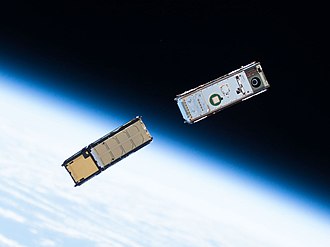 Two CubeSats orbiting around Earth after being deployed from the ISS Kibō module's Small Satellite Orbital Deployer
Two CubeSats orbiting around Earth after being deployed from the ISS Kibō module's Small Satellite Orbital Deployer A satellite or artificial satellite[a] is an object, typically a spacecraft, placed into orbit around a celestial body. Satellites have a variety of uses, including communication relay, weather forecasting, navigation (GPS), broadcasting, scientific research, and Earth observation. Additional military uses are reconnaissance, early warning, signals intelligence and, potentially, weapon delivery. Other satellites include the final rocket stages that place satellites in orbit and formerly useful satellites that later become defunct.
Except for passive satellites, most satellites have an electricity generation system for equipment on board, such as solar panels or radioisotope thermoelectric generators (RTGs). Most satellites also have a method of communication to ground stations, called transponders. Many satellites use a standardized bus to save cost and work, the most popular of which is a small CubeSats. Similar satellites can work together as groups, forming constellations. Because of the high launch cost to space, satellites are designed to be as lightweight and robust as possible. Most communication satellites are radio relay stations in orbit and carry dozens of transponders, each with a bandwidth of tens of megahertz.
Satellites are placed from the surface to the orbit by launch vehicles, high enough to avoid orbital decay by the atmosphere. Satellites can then change or maintain the orbit by propulsion, usually by chemical or ion thrusters. As of 2018, about 90% of the satellites orbiting the Earth are in low Earth orbit or geostationary orbit; geostationary means the satellites stay still in the sky. Some imaging satellites chose a Sun-synchronous orbit because they can scan the entire globe with similar lighting. As the number of satellites and space debris around Earth increases, the threat of collision has become more severe. A small number of satellites orbit other bodies (such as the Moon, Mars, and the Sun) or many bodies at once (two for a halo orbit, three for a Lissajous orbit).
Earth observation satellites gather information for reconnaissance, mapping, monitoring the weather, ocean, forest, etc. Space telescopes take advantage of outer space's near perfect vacuum to observe objects with the entire electromagnetic spectrum. Because satellites can see a large portion of the Earth at once, communications satellites can relay information to remote places. The signal delay from satellites and their orbit's predictability are used in satellite navigation systems, such as GPS. Space probes are satellites designed for robotic space exploration outside of Earth, and space stations are in essence crewed satellites.
The first artificial satellite launched into the Earth's orbit was the Soviet Union's Sputnik 1, on October 4, 1957. As of December 31st 2022, there are 6,718 operational satellites in the Earth's orbit, of which 4,529 belong to the United States (3,996 commercial), 590 belong to China, 174 belong to Russia, and 1,425 belong to other nations.[1]
History
Early proposals
The first published mathematical study of the possibility of an artificial satellite was Newton's cannonball, a thought experiment by Isaac Newton to explain the motion of natural satellites, in his Philosophiæ Naturalis Principia Mathematica (1687). The first fictional depiction of a satellite being launched into orbit was a short story by Edward Everett Hale, "The Brick Moon" (1869).[2][3] The idea surfaced again in Jules Verne's The Begum's Fortune (1879).
In 1903, Konstantin Tsiolkovsky (1857–1935) published Exploring Space Using Jet Propulsion Devices, which was the first academic treatise on the use of rocketry to launch spacecraft. He calculated the orbital speed required for a minimal orbit, and inferred that a multi-stage rocket fueled by liquid propellants could achieve this.
Herman Potočnik explored the idea of using orbiting spacecraft for detailed peaceful and military observation of the ground in his 1928 book, The Problem of Space Travel. He described how the special conditions of space could be useful for scientific experiments. The book described geostationary satellites (first put forward by Konstantin Tsiolkovsky) and discussed the communication between them and the ground using radio, but fell short with the idea of using satellites for mass broadcasting and as telecommunications relays.[4]
In a 1945 Wireless World article, English science fiction writer Arthur C. Clarke described in detail the possible use of communications satellites for mass communications. He suggested that three geostationary satellites would provide coverage over the entire planet.[5]: 1–2
In May 1946, the United States Air Force's Project RAND released the Preliminary Design of an Experimental World-Circling Spaceship, which stated "A satellite vehicle with appropriate instrumentation can be expected to be one of the most potent scientific tools of the Twentieth Century."[6] The United States had been considering launching orbital satellites since 1945 under the Bureau of Aeronautics of the United States Navy. Project RAND eventually released the report, but considered the satellite to be a tool for science, politics, and propaganda, rather than a potential military weapon.[7]
In 1946, American theoretical astrophysicist Lyman Spitzer proposed an orbiting space telescope.[8]
In February 1954, Project RAND released "Scientific Uses for a Satellite Vehicle", by R. R. Carhart.[9] This expanded on potential scientific uses for satellite vehicles and was followed in June 1955 with "The Scientific Use of an Artificial Satellite", by H. K. Kallmann and W. W. Kellogg.[10]
You received this message because you are subscribed to the Google Groups "1top-oldtattoo-1" group.
To unsubscribe from this group and stop receiving emails from it, send an email to 1top-oldtattoo-1+unsubscribe@googlegroups.com.
To view this discussion on the web visit https://groups.google.com/d/msgid/1top-oldtattoo-1/CAGNPKmmu0wSoNr1vt_s3oE8QaM-Ddc4kunoOzSjM0VmbdAvRaA%40mail.gmail.com.
No comments:
Post a Comment